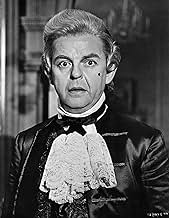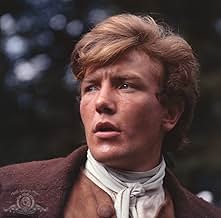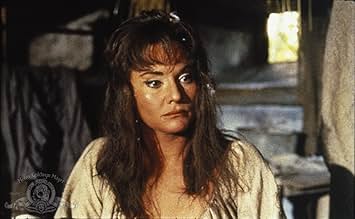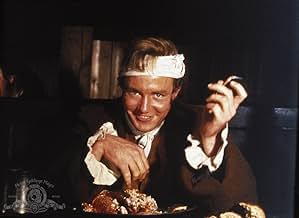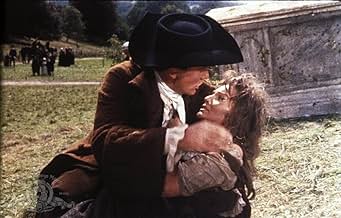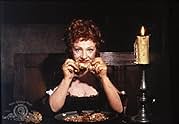ÉVALUATION IMDb
6,4/10
15 k
MA NOTE
Les aventures romantiques et chevaleresques du bâtard adopté Tom Jones dans l'Angleterre du 18e siècle.Les aventures romantiques et chevaleresques du bâtard adopté Tom Jones dans l'Angleterre du 18e siècle.Les aventures romantiques et chevaleresques du bâtard adopté Tom Jones dans l'Angleterre du 18e siècle.
- Director
- Writers
- Stars
- A remporté 4 oscars
- 20 victoires et 20 nominations au total
Avis en vedette
This was the period when French New Wave was supposedly reinventing cinema. Unfortunately, the French could only do so by citing Hollywood forms (mostly gangsters) and placing them in new contexts. That left lots of room for an intelligent Hollywood project to best them by exploiting itself. So much more could be done.
The rough form would be a contrast between the refined and the uncouth, between disciplined manner and unbridled lust, between old Hollywood presentation and the new. Thus, the uncouth merges with sex and the presentation used here.
That presentation form is at once hyperrealistic hand-held verity, engagement with running horses, A specific film joke where Tom and Sophie follow each other riding animals, widely varying lighting schemes using found light, frequent direct dialog with the audience and highly stylized "old" stuff: swordfights, wellworn plot closures, a typical love story but where the girl is halfway in the old and new worlds.
Make no mistake: the star of this is Suzanna York as our surrogate. Will we embrace this new manner of film-making, directly sensual and "real?" Of course we do, as much as no woman can refuse Tom
No serious watcher of film can omit this from their schedule. And it needs to be followed by "Barry Lyndon," and "Sex and Lucia."
Kubrick's project took this same story from the other side, the refined one. Its cinematography is lush and precise. But the project is one that contrasts nature (rather than raw sex acts) with foppish aristocracy (rather than general city society). But the intent is the same, to charm through images, just in Kubrick's case the images are aristocratic.
Medem's project is much more sophisticated, switching the dial so that the sex/repress, country/city, realistic/stylized image contrast is between experienced truth and written truth. But the same noir-like capricious fate is at work through copulation in Lucia as in Tom. The same idea as targeted woman, lovely desirable woman as the viewer's surrogate (and judge).
Ted's Evaluation -- 3 of 3: Worth watching.
The rough form would be a contrast between the refined and the uncouth, between disciplined manner and unbridled lust, between old Hollywood presentation and the new. Thus, the uncouth merges with sex and the presentation used here.
That presentation form is at once hyperrealistic hand-held verity, engagement with running horses, A specific film joke where Tom and Sophie follow each other riding animals, widely varying lighting schemes using found light, frequent direct dialog with the audience and highly stylized "old" stuff: swordfights, wellworn plot closures, a typical love story but where the girl is halfway in the old and new worlds.
Make no mistake: the star of this is Suzanna York as our surrogate. Will we embrace this new manner of film-making, directly sensual and "real?" Of course we do, as much as no woman can refuse Tom
No serious watcher of film can omit this from their schedule. And it needs to be followed by "Barry Lyndon," and "Sex and Lucia."
Kubrick's project took this same story from the other side, the refined one. Its cinematography is lush and precise. But the project is one that contrasts nature (rather than raw sex acts) with foppish aristocracy (rather than general city society). But the intent is the same, to charm through images, just in Kubrick's case the images are aristocratic.
Medem's project is much more sophisticated, switching the dial so that the sex/repress, country/city, realistic/stylized image contrast is between experienced truth and written truth. But the same noir-like capricious fate is at work through copulation in Lucia as in Tom. The same idea as targeted woman, lovely desirable woman as the viewer's surrogate (and judge).
Ted's Evaluation -- 3 of 3: Worth watching.
A fun and fresh screen adaption of British writer Henry Fielding's 18th Century novel of the same name, made at the threshold of the swinging (19)Sixties. Like the original story's French counterpart (Les Liaisons Dangereuses=Dangerous Liaisons), at its heart is a mannered metropolitan love triangle.
But before we arrive in the heart of London the stage is set amidst the lush green English countryside in Summer. Here we first meet the protagonist, Tom Jones, played by Albert Finney in his most youthful bloom, and his extended family representing every facet of post-Glorious Revolution England.
An incorrigible ne'er-do-well, Tom's genuine love for his neighbor Squire Alworthy's daughter Sophie (a very lovely Susannah York), takes him to the heart of fashionable London society in a series of comedic wrong-turns and misunderstandings. Here he becomes embroiled in the games of the jaded aristocrat Lady Bellaston played by Joan Greenwood. Greenwood steals the show as the original Mrs. Robinson and, through her machinations, Tom is led to the gallows. But at the last minute...
Throughout the movie is paced with a modern sense of realism, made effective by hand-held camera sequences and the quick editing of Antony Gibbs. Old-fashioned film techniques are used effectively with eye-to-the-camera realism, and convey an up-to-date feel. There are moments of beauty as well as comedy in this very satisfying entertainment. The cast is stellar with many familiar names--Hugh Griffith, Rachel Kempson, David Warner (in his first movie), the settings realistic, and the the musical score a perfect fit. A great time overall!
An interesting note, supposedly this is the last movie seen by John F. Kennedy (in a White House screening) before he was assassinated.
But before we arrive in the heart of London the stage is set amidst the lush green English countryside in Summer. Here we first meet the protagonist, Tom Jones, played by Albert Finney in his most youthful bloom, and his extended family representing every facet of post-Glorious Revolution England.
An incorrigible ne'er-do-well, Tom's genuine love for his neighbor Squire Alworthy's daughter Sophie (a very lovely Susannah York), takes him to the heart of fashionable London society in a series of comedic wrong-turns and misunderstandings. Here he becomes embroiled in the games of the jaded aristocrat Lady Bellaston played by Joan Greenwood. Greenwood steals the show as the original Mrs. Robinson and, through her machinations, Tom is led to the gallows. But at the last minute...
Throughout the movie is paced with a modern sense of realism, made effective by hand-held camera sequences and the quick editing of Antony Gibbs. Old-fashioned film techniques are used effectively with eye-to-the-camera realism, and convey an up-to-date feel. There are moments of beauty as well as comedy in this very satisfying entertainment. The cast is stellar with many familiar names--Hugh Griffith, Rachel Kempson, David Warner (in his first movie), the settings realistic, and the the musical score a perfect fit. A great time overall!
An interesting note, supposedly this is the last movie seen by John F. Kennedy (in a White House screening) before he was assassinated.
This was a great film in its time, and is still a great one today. Well-directed, well-acted, well-shot, great soundtrack, and based on a splendid literary vehicle.
It's frustrating to see so much uninformed voting and so many uninformed remarks on this otherwise wonderful site; I guess its inevitable since anyone can post anything. But I would like to point out that Tom Jones did not sleep with his mother as erroneously alleged, and that Albert Finney, 26 or 27 years old at the time of shooting this film, clearly did not look too old for his part.
I haven't read the book(s), but from the film it's obvious that Dickens was much indebted to Fielding, using his amazing invention as a convoluted plot model (and perhaps a character-naming model) for many of his works.
Go rent this film after seeing Finney in the currently playing Big Fish -- it's great to see him do so well in such very different films made in different millenia, nearly a full professional lifetime apart.
It's frustrating to see so much uninformed voting and so many uninformed remarks on this otherwise wonderful site; I guess its inevitable since anyone can post anything. But I would like to point out that Tom Jones did not sleep with his mother as erroneously alleged, and that Albert Finney, 26 or 27 years old at the time of shooting this film, clearly did not look too old for his part.
I haven't read the book(s), but from the film it's obvious that Dickens was much indebted to Fielding, using his amazing invention as a convoluted plot model (and perhaps a character-naming model) for many of his works.
Go rent this film after seeing Finney in the currently playing Big Fish -- it's great to see him do so well in such very different films made in different millenia, nearly a full professional lifetime apart.
Just two hundred years after Henry Fielding's novel appeared, the theatre-actor-turned-cinema-director Sir Tony Richardson rounded up a few Shakespearean-trained prodigees, got John Addison to compose hectic clavichord accompaniment a little in the style of Handel operas and set all this against lush photography to produce one of the most hilarious films of the last five hundred years. Fielding's novel which is a most definite recommendation rather cynically but good-humouredly exposed mid-eighteenth century British hypocrisy at its best and the landed gentry's obsession for fox-hunting at its worst. Richardson directed all this a bit like an elderly Sir Thomas Beecham ('the important thing is we all start and stop together; nobody notices what happens in between') raising his baton in front of the London Symphony Orchestra: the result in both cases is astounding. Richardson conducts his piece at a tremendous pace, Addison's clavichord tripping along gaily so as to keep up the illusion, and visual sequences such as a young trouserless Albert Finney escaping out of a window, shinning down a tree and running off into the nocturnal depths of a beech forest, all combine to keep you breathlessly awaiting the next scene. Susannah York is just delicious, with that innocent facial beauty that raises heartbeats, especially in the latter parts; and Angela Baddely as Mrs. Wilkins and Diane Cilento as Molly play some great scenes. And some of the great scenes are worth telling...... Tom and Mrs. Wilkins enjoy a good roast with fruit, eating lusciously and lascivously, eating each other up with their sparkling eyes: this scene is hugely delightful. The other great scene is the fox-hunt: this alone puts the whole film into a special category: brilliant film-making, almost comparable to the famous chariot race in Ben Hur........ I loved this film 37 years ago, and recently had the luck to see it again: having doubled my years, I was just as enthralled and enraptured as the first time. A splendid piece of art.
While my mother claims this is a "guy movie," I'm not a guy and find it one of the funniest, most charming movies ever made. The narration, music and just plain spunky tone of this movie makes it a unique piece -- you really DO have to see it to understand what it's all about! I highly recommend this movie -- as well as the book, which was published in 1749 but is just as funny today and highly readable, not "quaint" at all!
Oscars Best Picture Winners, Ranked
Oscars Best Picture Winners, Ranked
See the complete list of Oscars Best Picture winners, ranked by IMDb ratings.
Le saviez-vous
- AnecdotesIt took two nights to film the sequence in which Squire Western chases after Tom. The second night, Hugh Griffith managed to undo the wiring on his riding crop, and actually hit Albert Finney with it, drawing blood. In character, Finney turned on Griffith and said, "I can't abide to be whipped, Squire," then punched him in the face. Each stalked off the set, swearing never to work with the other again.
- GaffesAfter Lady Bellaston reads Tom's letter proposing marriage, she wads it into a small ball. Lady Bellaston later shows the letter to Sophie's aunt, but it is now smooth and uncrumpled.
- Générique farfeluOpening credits: In the west of England there was once a Squire Allworthy. After several months in London he returned home. his sister, Bridget. his servants. after supper. "Mrs. Wilkins!" "aaah!" a baby! abandoned!!! "how did it get here?" "who can the mother be?" "Jenny Jones!" "who is the father Jenny?" "send for Partridge the barber!" Partridge the barber - the father? "I will deal with you later, sir!" "you must be sent away from this shame and degradation." "as for your child . . . . . " "I will bring him up as if he were my own son." "what will you call him brother?" "Tom Jones." of whom the opinion of all was that he was born to be hanged.
- Autres versionsFor the 1989 reissue/restoration, the director trimmed approx. 7 minutes from the original. The initial home video release in 1981 on the Magnetic Video label contains the full-length original, which includes the following footage/dialogue cut from the reissue:
- Tom running from Squire Western; Black George caught for killing sheep; trial
- Sophie: "Oh, my little bird."
- Molly being called a slut by her family: "You will have a bastard"
- Tom/Sophie montage: Tom reading, eating nuts, picking berries, Tom and Sophie singing
- Teachers fighting Tom; Tom going around tree; riding teacher
- Tom's dream at the Inn
- Sophie and Lady Fitzpatrick: Trimmed frames from laughing
- Sophie and Lady Fitzpatrick: "What will you do in London?" "I have a friend..."
- Sophie and Lady Fitzpatrick: "What about your friend?" "He is away for a few days. When he returns we shall make other arrangements."
- Lady Bellaston and Lady Fitzpatrick: "The girl is obviously intoxicated and nothing less than ruin will content her."
- Lady Bellaston muttering French phrase at dinner
- Lady Bellaston: Dialog after "Are you afraid of the word 'rape'?"
- Transition from Bellaston and Fellamore to Tom and Partridge
- Transition from Tom and Partridge to "Rape"
- Partridge and Tom: "She'll be the one to break it off"; transition to note; dialog: Narrator reads letter, Bellaston remarks to maid not to receive Tom Jones again.
- "Scandal are the best sweeteners of tea."; transition
- Partridge looking for people to uphold Tom's character (in the original he approaches one man, then two more - scene of him approaching the first man was cut)
- No reprise of song for Tom as he's going to be hanged
- End titles (re-done for reissue with restoration credits and extended music by 15 seconds, while cutting some of the original company credits)
- ConnexionsFeatured in Precious Images (1986)
Meilleurs choix
Connectez-vous pour évaluer et surveiller les recommandations personnalisées
- How long is Tom Jones?Propulsé par Alexa
Détails
Box-office
- Budget
- 1 000 000 $ US (estimation)
- Durée
- 2h 9m(129 min)
Contribuer à cette page
Suggérer une modification ou ajouter du contenu manquant



